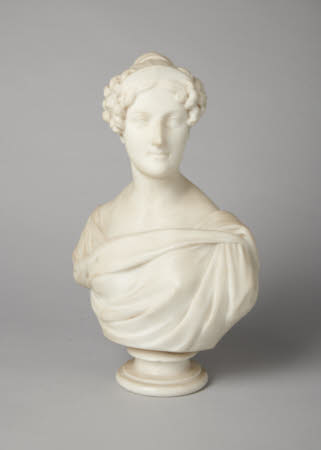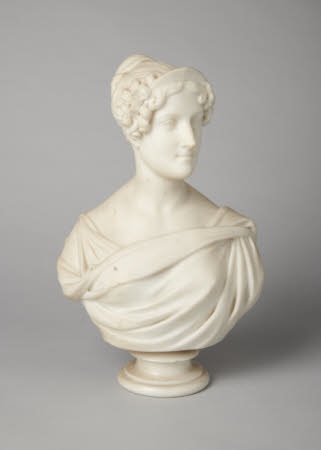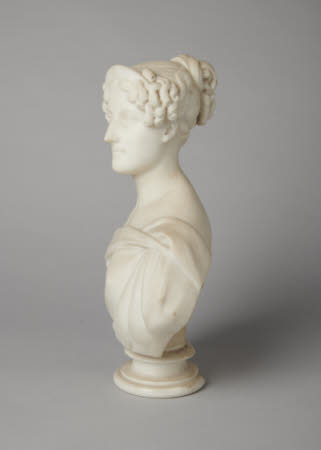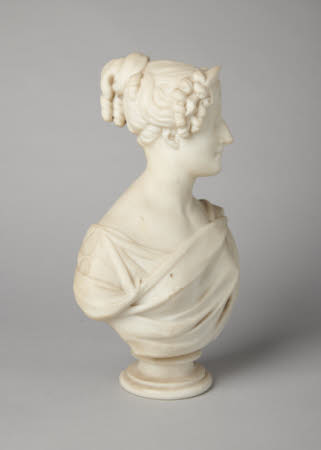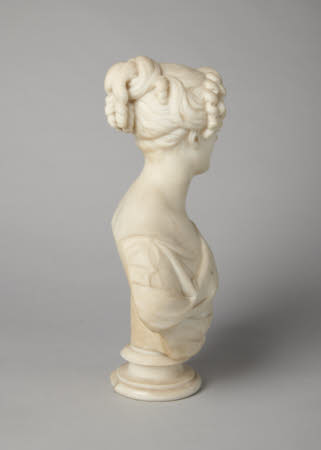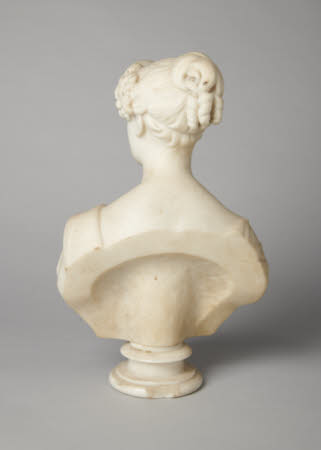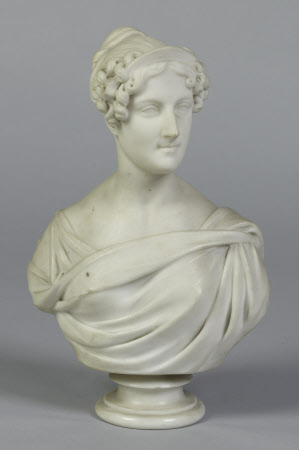Portrait bust of Harriet Elizabeth Georgiana Leveson-Gower, Duchess of Sutherland (1806-1868)
Roy Coles
Category
Art / Sculpture
Date
c. 1823 - 1835
Materials
Carrara marble
Measurements
325 mm (H); 223 mm (W); 121 mm (D)
Place of origin
Great Britain
Order this imageCollection
Mount Stewart, County Down
NT 1220128
Summary
Sculpture, marble; Portrait bust of Harriet Elizabeth Georgiana Leveson-Gower, Duchess of Sutherland (1806-1868); British; c. 1823-35. A portrait bust in marble of the Duchess of Sutherland, who became one of the leading political hostesses of the first half of the nineteenth century, and was well-known for her passionate commitment to liberal causes, including championing the fight to abolish slavery, especially in the United States.
Full description
A small portrait bust in marble depicting Harriet Elizabeth Georgiana Leveson-Gower, Duchess of Sutherland (1806-1868). She is portrayed facing to her left, wearing in her head an arched diadem, her hair in ringlets at the sides and drawn into an elaborate bun at the back of her head. She is dressed in loose robes with a swag of drapery across her front. Mounted on a turned marble socle. Harriet, Duchess of Sutherland was one of the best-known figures in British society during the middle decades of the nineteenth century. The vast wealth of the Sutherland family enabled her to champion numerous liberal causes and to enjoy considerable influence in political and court circles, but also opened her to criticism from those who remarked on the disparity between her extravagant lifestyle and the poverty of the family’s tenants on its estates, especially in northern Scotland. She was born Harriet Georgiana Howard, one of three daughters of the sixth Earl of Carlisle. In 1823, at the age of just seventeen, she married her cousin George Granville Leveson-Gower (1786–1861), then Earl Gower and later Marquess of Stafford and, from 1833, Duke of Sutherland. Described as ‘large, boisterous, and charming’, Harriet was a great enthusiast and advocate. She quickly became a leading figure in society, especially after her husband succeeded as Duke of Sutherland in 1833. In 1837 she became mistress of the robes to the young Queen Victoria and was subsequently a close friend to the queen and her consort Prince Albert, especially after Albert's death in 1861. Harriet’s friendship with Queen Victoria was only strengthened by her own husband’s death in the same year. Harriet Sutherland was the driving force behind a vast and expensive programme of refurbishment of the family’s existing houses, as well as the acquisition of new properties, notably Cliveden, bought in 1849. This extravagance was compared unfavourably with the conditions under which many of the Sutherlands’ tenants lived, not to mention those who had been forced to emigrate during the Highland clearances. The Duchess’s religious beliefs engendered in her a strong commitment to a range of causes, including the abolition of slavery in the United States. Her support included assistance to Harrriet Beecher Stowe’s campaigns and the organisation of a meeting in November 1852 at Stafford House. If her support for the abolition of slavery did not materially advance the cause, it unquestionably helped to spread awareness and to publicise the movement in Britain. The Duchess was also a strong supporter of the cause of Italian nationalism, welcoming Giuseppe Garibaldi to her homes, to the displeasure of Queen Victoria. In her latter years she developed an especially close relationship with the politician William Gladstone. This small bust shows Harriet Sutherland at a young age, her hair suggesting a date in the 1820s or perhaps the early 1830s. It may be a reduction of a larger sculpted portrait, perhaps made around the time of her marriage. A small medallion by William Bain (fl. 1825, died 1862) depicting the Duchess of Sutherland in 1837 (an example at Mount Stewart, NT 1219806), shows her with a much more tightly controlled hairstyle. Harriet, Duchess of Sutherland was the great-grandmother of Edith, Marchioness of Londonderry, who spent much of her childhood at the Sutherland seat, Dunrobin Castle, after the early death of her mother Florence, daughter of the 3rd Duke of Sutherland. The bust is recorded in the Yellow Drawing Room of Londonderry House in London in an inventory drawn up in 1939, in which it was recorded that the bust was bequeathed to Edith by her great uncle, Harriet’s son Lord Ronald Sutherland Gower (1845-1916), who practised as a sculptor. Jeremy Warren July 2022
Provenance
Lord Ronald Sutherland Gower (1845-1916), by whom bequeathed to Edith, Marchioness of Londonderry (1878-1959); 1939, Londonderry House, Yellow Drawing Room; 1949, 24 Hertford Street, London, Drawing Room; Lady Mairi Bury (1921-2009); lent to the National Trust in 1976; accepted by HM Government in lieu of Inheritance Tax and allocated to the National Trust in 2013.
Makers and roles
Roy Coles, sculptor
References
Londonderry House 1939: A Catalogue and Valued Inventory of the Furniture and Works of Art at Londonderry House, Park Lane, W... Prepared for the purposes of insurance, with historical notes, by H. Clifford-Smith, 1939, p. 68. 24 Hertford Street 1949: Inventory and Valuation of the Contents of Londonderry House, 24, Hertford Street, W. The property of the Most Honourable the Marquess of Londonderry… deceased. Prepared for the purpose of probate by H. Clifford-Smith. 1949., p. 13.
